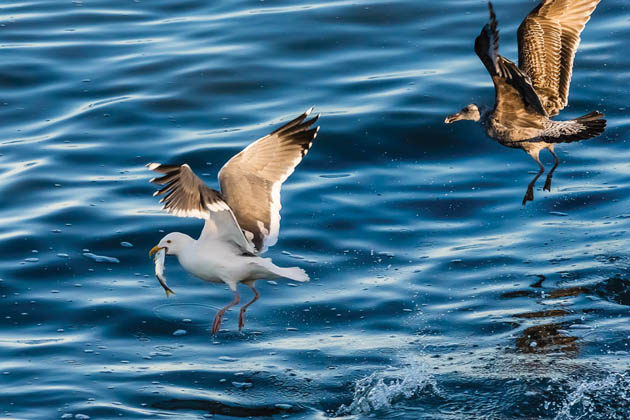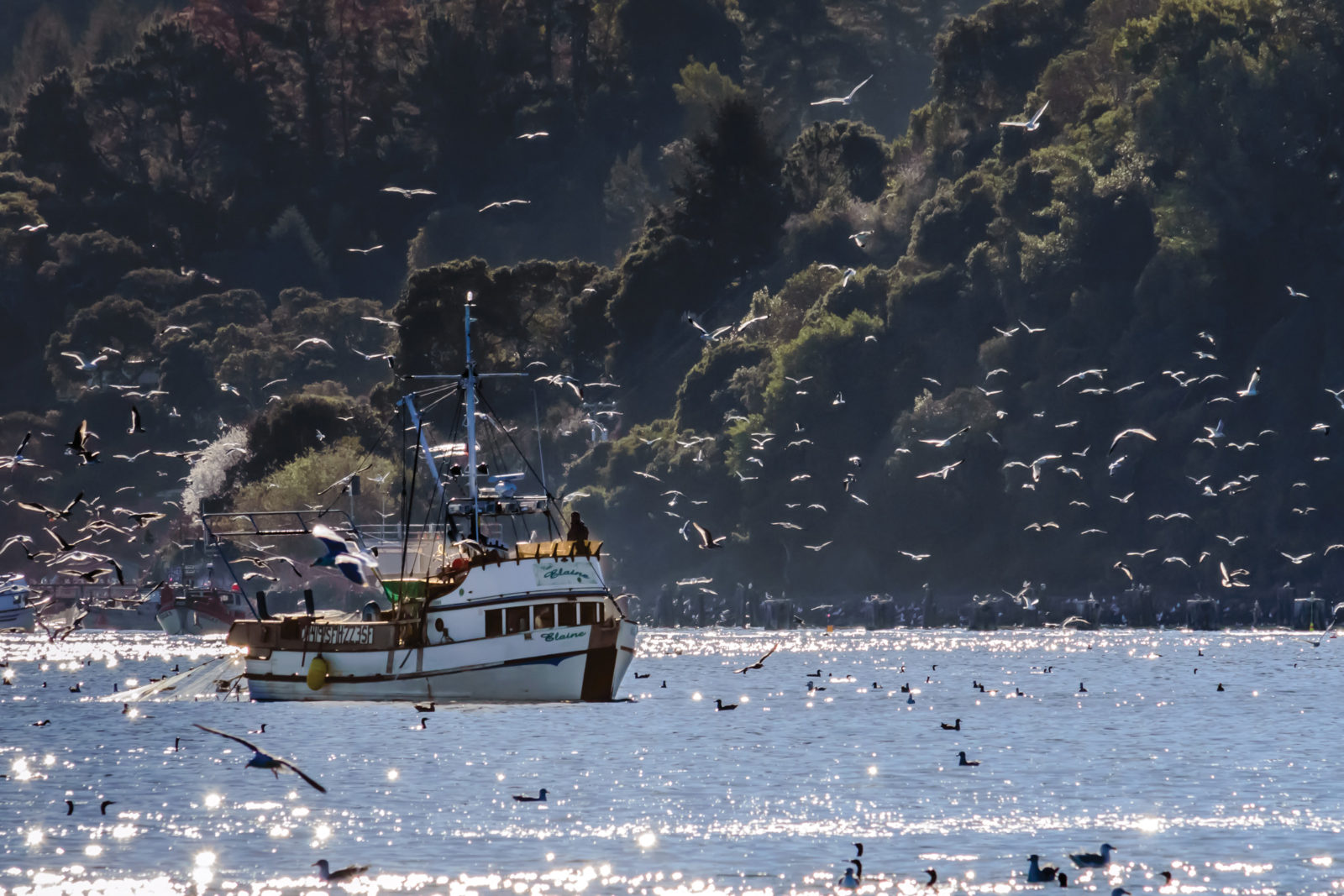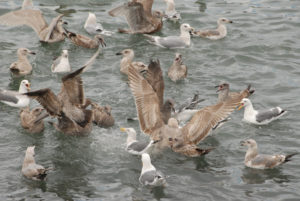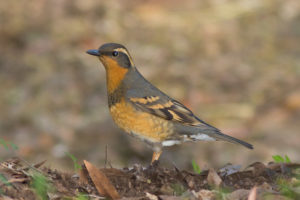Between November and March in the winter of 2013-2014, 60,600 tons of Pacific herring swam into the San Francisco Bay to spawn. That’s a lot of small fish: 300 blue whales’ worth; 8,600 elephants’ worth; 50,000 great white sharks’ worth. The pulses in that silver fish wave, reaching up to a mile long by a mile wide, represent perhaps the largest aggregations of animals you’ll ever find in Northern California.
When hundreds of millions of tasty, oil-rich fish arrive in one spot and commence spraying high-protein eggs everywhere it becomes a scene: a mayhem of shrieking birds, snorting pinnipeds, and thrumming fishing boats. The eggs, billions and billions of them in long strings, wash up at the feet of birders assembled on the shoreline. From the shore you can see the birds rafting by the thousands, a mile-long debris field across the surface of the water. Gulls rise and fall, screaming; seals, sea lions, and porpoises surface and dive; and through binoculars the raft becomes a kaleidoscopic frenzy of frothing heads and tails and ripples and splashes. It’s a spectacle you can easily witness in person, and like a salmon run or a wildebeest migration, it’s a direct connection with nature’s enormousness. And that’s just on the surface. You can only imagine what it looks like underwater.
“We assume it looks like this swirling ball of fish moving through the Bay,” says Ryan Bartling, a fisheries scientist with the California Department of Fish and Wildlife. “I’d love to say we have video, but herring are pretty skittish.”
The cause of all the excitement is a smallish schooling fish, ranging roughly from 4 to 8 inches long and from one tenth to one third of a pound, made for blending in with the ocean and with the school. The primary impression of herring even in video is going to be the flash of silver scales as they swim by, although what video exists is mainly from spawns in British Columbia. (Stay tuned: Bartling says Bay herring fishermen chipped in to buy Fish and Wildlife a GoPro to use this year.)
The Pacific herring, Clupea pallasiione, is one of three herring species worldwide, and one of the top five most important prey fish off the West Coast. Yet there’s surprisingly little information about what adult herring do for the 11 months a year when they’re not spawning: we know they’re out in the ocean, riding the California Current, eating macroplankton, schooling up in Monterey Bay in the summer, but why and where and for what—aside, of course, from feeding bigger animals, which is probably not the herring’s choice —are still mostly open questions. Even research cruises only occasionally pick them up, Bartling says.
“We still lack good data on the ocean phase for Pacific herring off the California coast,” Bartling says. “When they leave San Francisco Bay we have a general sense of where they go, but we don’t fully understand the total extent of their summer range or the potential for mixing with other herring schools from other spawn locations.”
So Bartling and other scientists stick to what they can see in front of them: the spawn. The Bay is one of the herring’s major spawning sites on the west coast of North America and the largest south of British Columbia. It’s also not clear exactly why herring pick the exact spawning areas within the Bay that they do, but Richardson Bay is the critical spot, the “epicenter within the epicenter,” says Audubon California Seabird and Marine Program Manager Anna Weinstein. About three-quarters of the 2013-2014 spawn happened in Richardson Bay. Probably not coincidentally, the Richardson Bay Audubon Center and Sanctuary recorded its highest-ever bird count in December 2013.

The high herring and bird numbers in Richardson Bay the last few years are an anomaly on the West Coast, where herring and the birds that love them are in general decline together. One study in the October 2014 issue of the journal Conservation Biology tied 20-year declines in wintering birds in British Columbia’s Salish Sea to their forage fish diet, and particularly to herring declines in the sea and Puget Sound. Surf scoters, Simon Fraser University ecologist Erika Lok argued in a 2012 paper, follow a “silver wave” of herring spawns in their spring migrations; the charismatic sea ducks have declined in San Francisco Bay, possibly because of the depressed herring populations elsewhere along the coast.
Herring numbers in San Francisco Bay were down about 10 percent last winter from the year before, but still above average (the average, since the California Department of Fish and Wildlife started tracking in 1979-1980, is 52,000 tons), which most observers attributed to the drought. Bartling said he expects another good year in 2015, but given the lack of ocean data he won’t be able to start putting a number to it until February; herring, he says, will always surprise you. “In the 40-plus years that we’ve been conducting research and managing the fishery,” Bartling says, “the only predictable thing about herring is that they’re unpredictable.”
Roughly speaking, the big herring schools swim into the Bay beginning in the late fall. They will “stage” for as much as a few weeks, milling about according to some still-unexplained-by-science fish whim, until suddenly the alarm clock rings and the spawn begins. The trigger is probably a combination of temperature, salinity, substrate, and predation (fishing boats chasing the school sometimes trigger spawns). But when the signal goes, the school rushes to shallower waters. Males release their milt first, along with a pheromone that alerts the females. Females then release adhesive eggs a few thousand at a time directly onto underwater vegetation and structures, making repeated passes until eelgrass, moss, rocks, and riprap are blanketed with the small gelatinous spheres. Larger females can have as many as 50,000 eggs, and one CDFW report says the eggs can cover a 20-mile stretch of shore with a 30-foot band of eggs. Picture a 30-foot-wide bathtub ring around Richardson Bay and you get the idea.
The odds for any individual egg are not good, of course. Survival is at best a 50 percent proposition, depending on both predation and environmental conditions. The embryos that survive turn into larvae, which then metamorphose into juvenile fish, which hang around the Bay until sometime in the fall before swimming out to sea. Herring can live up to 10 years and reach sexual maturity by age three, although surveys of recent spawns in the Bay have shown a skewed age distribution that features more one- and two-year-old fish than expected.
That’s one of several concerns for the small commercial herring fishery, which both conservationists and agency scientists say has lately been a model for responsible fishing. Fishermen, conservationists and scientists are currently working on a long-term fisheries management plan, to ensure that future catch will be sustainable. Which is one reason Geoff Shester, the California Program director at Oceana and a marine biologist who studies forage fish in the California Current, says herring shouldn’t just be for the birds. “Herring are more sustainable than any other protein source on the planet that you can buy,” he told me.
In fact, he told me this repeatedly. Shester was once vegan, and then did a calculation that he says showed that local herring are better for the environment than even lentils, the lowest-carbon-footprint vegetable protein. If IKEA is the only herring retailer you know (SILL VITLÖK, marinated herring with garlic sauce), take heart: you don’t have to eat your herring pickled from Scandinavia in the cafe of a postmodern furniture warehouse. Buy it local and eat it fresh, Shester says, and herring will surprise you with its mild, tender flavor. “This is one of the few urban fisheries in the country, where you have people fishing herring a few feet away from the Embarcadero or the Sausalito waterfront,” Shester says. “You can almost touch these nets from shore. Why isn’t it being sold on every street corner? Anyone who cares about carbon footprint should eat local Bay herring over tofu.”





